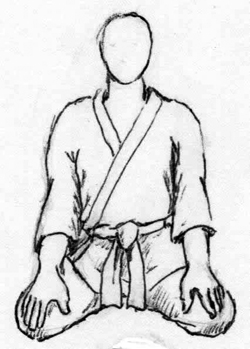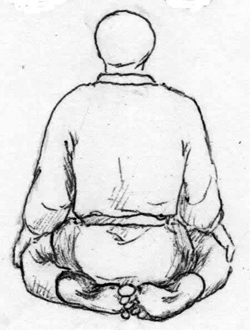The Glossary
ATTACKS
GYAKU (yah-kuh) : facing your partner - opposite hand grab (right to left hand/left to right hand).
KATA-DORI (kah-tah-doh-ree) : shoulder grab.
KATATE-DORI (kah-tah-teh-doh-ree) : single-wrist grab.
KOSADORI (koh-sah-doh-ree) : same hand grab (katatedori ai-hanmi - right to right/left to left).
MOROTE-DORI (moh-roh-tay-doh-ree) or RYOTE MOCHI (rio-tay moh-chee) : two hands grab one wrist.
RYOTE-DORI (rio-tay-doh-ree) : both your opponent's hands grabbing one wrist each.
SHIME (she-may) : to squeeze or choke.DOJO (doh-joe) : place of the Way; a place for strengthening and refining the body, mind and spirit.
DOMO ARRIGATO GOZAIMASHITA (doh-moh-ari-gah-toh-go-zai-mas-tah) : formal reply "thank you very much."
DOMO ARRIGATO GOZAIMASU (doh-moh-ari-gah-toh-go-zai-mas) : formal "thank you."
GI (ghee) : also KEIKOGI (kay-koh-ghee) or DOGI (doh-ghee); white training uniform.
HAKAMA (ha-ka-ma) : Traditional outer garment that resembles large-wide pants. It has seven pleats and a koshiita - i.e. a stiff or padded part in the lower back of the wearer.
KAMAE (kah-mah-ey) : posture of readiness.KAMAE POSITIONS
JODAN (jaw-dahn) : high / upper position - raising the weapon to the forehead.
GEDAN (gey-dahn) : low position.
WAKI (wah-ki) : holding the weapon byone's side, sometimes to hide its length. In our dojo, it is held at the side with both hands, in an unbroken line extending from the left arm to the kissaki of the sword.
HASSO (hah-soh) : literally "eight" (directions), refering to being able to respond to all directions, with the weapon held above the right or left shoulder.KAMIZA (kah-mee-zah) : translated as "seat of the god" where the picture of the founder and words AI-KI-DO are located at the front of the dojo (Shomen).
KAMIZA
The Kamiza is also known as the 'upper seat' or literally translated as 'seat of god'. Located at the 'shomen' or front/correct facing of the dojo, this wall is sometimes referred to as the 'north wall'. The dojo entrance would traditionally be located on the opposite wall, known as the 'lower seat' or 'shimoza'.
The Kamiza may have a raised platform (known as the 'shinden'), where the founder of the ryu, visiting dignitaries, or chief instructor would sit while the class is in progress. In most dojos today, the shinden is more symbolic, rather than an actual platform for sitting.
KEIKO (kay-koh) : practice.
MAAI (mah-aye) : proper distance from the opponent.
MAAI
NAGE (nah-gay) or TORI (tor-ree) : the person applying a technique.
OBI (oh-bee) : the belt.
TYING THE OBI
ONEGAISHIMASU (oh-nay-gai-shmas) : "please" or asking a favor, in this case, to train together.
REI (ray-ee) : respect, normally shown through a bow or formal bow (seated).
SEIZA (say-zah) : formal sitting position; the only proper sitting posture on the mat.
SEIZA
To be comfortable, sit upright with both feet forming a depression to sit in. Place the right big toe over the left big toe. Remain alert and respectful, while sitting with a relaxed mind.SHIHO (shee-ho) : literally means (the number) "four".
SHIKKO (shee-koh) : knee-walking.
SHIKKO
UCHI (oo-chee) : strike
STRIKES
MUNE-TSUKI (moo-nay-chu-kee) : thrust (punch) to the chest (solar plexus).
NANAME UCHI (nah-nah-may oo-chee) : slanted, diagonal strike, a more acute angle than Yokomenuchi.
SHOMEN-UCHI (show-men-oo-chee) : vertical strike (chop) down to the top of the head.
SHOMEN-TSUKI (show-men-chu-kee) : thrust (punch) to the face.
TSUKI (chu-kee) : thrusting or punch.
YOKOMEN-UCHI (yeoh-koh-men-oo-chee) : diagonal strike (chop) to the side of the head / neck.
UCHI-DESHI (oo-chee-day-shee) : live-in disciple who trains and serves the master.
UKE (oo-kay) : literally means "to receive"; the person who attacks and receives the response.
UKEMI (oo-kay-mee) : the art of receiving and "falling".
UKEMI - BREAKFALL
UKEMI - MAE UKEMI (FORWARD ROLL)
UKEMI - USHIRO UKEMI (BACKWARD ROLL)
Positions / Directions:
HANMI (hah-mee) : relaxed triangular (T) "half-body" standing position.
HIDARI (hee-dah-ree) : left side.
MIGI (mee-ghee) : right side.IRIMI (ee-ree-mee) : entering.
TENKAN (teng-kahn) : turning away or pivoting.
KAITEN (kahee-ten) : literally means to open and turn.MAE (mah-ey) : forward.
OMOTE (oh-moh-tay) : to the front or 'live' side of the opponent.
SHOMEN (show-men) : the front or top of head; also upper seat on the mat and the front of the dojo.
SOTO (soh-toh) : outside.
UCHI (oo-chee) : inside.
URA (oo-rah) : to the rear on the opponent's "blind side".
URA-WAZA (oo-rah wah-zah) : turning and blending around the opponent's "blind side", to the back.
USHIRO (oo-shee-roh) : to the rear or behind the opponent (ie the back).
YOKO (yeoh-koh) : means "horizontal" - although the strike follows a diagonal path in Aikido practice.Techniques:
IRIMI-NAGE (ee-ree-mee-nah-ge) : entering throw.
SHIHO-NAGE (shee-ho-nah-ge) : four-direction throw.
KAITEN-NAGE (kahee-ten-nah-ge) : open-and-turn throw / rotary throw.
KOKYU-HO-NAGE (koh-kiu-ho-nah-ge) : "breath" throw.
TENCHIN-NAGE (tien-chin-nah-ge) : literally means "heaven and earth" throw.
KOTE-GAESHI (ko-tay-gai-she) : wrist twist throw / lock.OMOTE-WAZA (oh-moh-tay-wah-zah) : forward techniques, into the 'live' side of attacker.
URA-WAZA (oo-rah-wah-zah) : pivoting around the side, into the 'blind' side of the attacker.
USHIRO-WAZA (oo-shee-roh-wah-zah) : rear techniques.
OSAE-WAZA (oh-zah-ey-wah-zah) : pinning techniques.IKKYO (ee-kyoh) : First teaching/ first pin.
NIKYO (nee-kyoh) : Second teaching/ second pin - wrist lock.
SANKYO (sahn-kyoh) : Third teaching/ third pin - hand twist lock.
YONKYO (yong-kyoh) : Fourth teaching/ fourth pin - forearm nerve lock.
GOKYO (gor-kyoh) : Fifth teaching/ fifth pin - grab back of wrist.JO-DORI (joh-doh-ree) : short-staff take-away techniques.
TACHI-DORI (tah-chee-doh-ree) : bokken/sword take-away techniques.
TANTO-DORI (tahn-toh-doh-ree) : knife take-away techniques.Weapons:
Traditionally, Jo and Bokken practice in Ueshiba Aikido dojos are reserved for 4th Kyu students and above. Tanto (knife) takeaways may be practiced from 6th Kyu.
The basic premise is to enable the beginning practitioner to first find their own balance whilst performing basic unarmed techniques. When the student is able to perform unarmed techniques fairly competently, then weapons are introduced in stages. By this time, the student would be able to experience the weapon as an extension of the body and not as an external object.
©
Ueshiba Aikido Victoria, BC, Canada: OWH Industries
Webpages & Illustrations by Rafael Oei
Victoria, BC, Canada
Updated:
4 September, 2020






